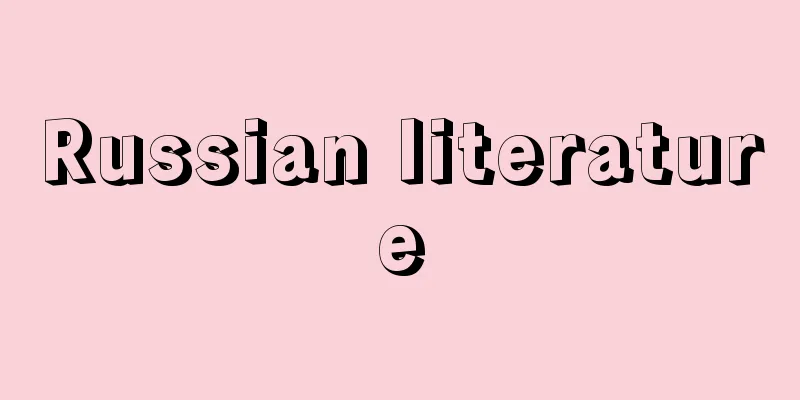Russian literature

|
The history of Russian literature, which spans almost 1,000 years from the 11th century to the present day, can be broadly divided into the Middle Ages (traditionally called ancient in Russia) and modern times, with the reforms of Peter the Great in the early 18th century as the dividing line. Furthermore, literature produced after the establishment of the Soviet regime (1917) has been called Soviet literature, and has been distinguished from Russian literature produced before the revolution. However, since the collapse of the Soviet Union in 1991, the country has entered the "post-Soviet era," a chaotic time due to the loss of socialist values, and postmodern tendencies are also emerging in the literary world. [Takashi Egawa and Shoichi Kimura] The history of Russian literatureAncientThe possibility of the development of Russian literature was given to the Kievan Rus's state religion at the end of the 10th century, around the time that it adopted Greek Orthodoxy as its state religion, when translations of Byzantine religious texts written in what is known as Church Slavonic were brought in, mainly from Bulgaria. Church Slavonic was a literary language based on the vernacular language of Macedonia, which was very close to the Russian language of the time, and after it was introduced into Russia it was also used for secular purposes, and was more prevalent than Russian itself until the 17th century. In the history of Russian literature, the period of about 650 years from the mid-11th century, when the oldest surviving document, the Ostromir Gospel, was written, to the end of the 17th century, is generally referred to as the "Ancient Period." The works of this period are generally dominated by works with a strong religious or didactic tone, or those with a tendency toward "social and political commentary" that served some practical purpose. However, in addition to written literature, it is clear that a rich genre of purely secular and artistically excellent oral literature had already existed before the 11th century, and it is believed that the aesthetic desires of "ancient" Russians were primarily satisfied by this oral tradition. These folklore works include not only prose genres such as fairy tales and tales, but also a wealth of poetic genres such as ritual songs and lyric songs. In particular, the ancient heroic epics known as "Bylina" are highly artistically valuable. They sing of the semi-mythical, semi-historical past of the Russian people, with giant knights such as Ilya Muromets, Dobrynya Nikitich, and Mikula as their main characters. [Takashi Egawa and Shoichi Kimura] Kyiv periodThe "Kievan period" (11th-13th centuries) produced two highly original works, the "Russian Chronicles" (early 12th century) and "Tale of Igor's Campaign" (1185-1187), in addition to works of purely ecclesiastical genre such as hagiographies such as "The Life of Boris and Gleb" and "The Life of Feodosii of Pechora" and sermons such as Prince Vladimir Monomakh's "Instructions." The former was created in a monastery in Kiev and has great literary value in the parts that incorporate old oral traditions, while the latter (author unknown) is a purely secular work that freely uses highly complex stylistic techniques and is a masterpiece that occupies the highest rank in ancient literature. In addition, pseudepigrapha of the Byzantine Bible, such as "The Torment of the Virgin Mary" and "The Words of Adam in Hell to Lazarus," went beyond the realm of translation and became the source of Russian literature. The tradition of Kievan literature, which produced such high-level works, died out during the period of Tatar rule from the 13th century to the end of the 15th century, and from the end of the 14th century, empty hagiographies that placed an extreme emphasis on rhetorical technique became mainstream, a trend that continued into the following Moscow period (16th and 17th centuries). Alongside this, works of "social and political commentary" that reflected the intense religious and political conflicts within the Moscow state were a literary phenomenon characteristic of the 16th century. Among these, the Domostroi (Family Instructions), which reflect the thinking of Novgorod's merchant class in the early 16th century, have unique value. In the 17th century, new elements began to appear in literature as a result of the "Time of Troubles" at the beginning of the century, which had shaken the old Moscow state structure to its very core. For example, works in the genre of "secular tales" in the second half of the century had little or no religious overtones, and depicted scenes from everyday life. Some of them were heavily influenced by oral tradition and sometimes even satirized the society of the time. In addition, the Separatist leader Abbacombe broke away from the traditional form of hagiography by describing his own life in a vivid and candid manner using colloquial language in his remarkable Autobiography (1672-1675), and the court poet Simeon Polotskii (1629-1680) wrote many works in the fields of poetry and drama, which were not seen in the past, under the influence of Poland and Western Europe. [Takashi Egawa and Shoichi Kimura] 18th centuryThe process of secularization, Westernization, and modernization of Russian society that began in the 17th century was rapidly accelerated by the bold reforms of Peter I, but in the field of literature as well, ancient literary traditions were almost completely cut off, and Western trends of thought were introduced one after another, under whose influence a purely secular modern Russian literary tradition was gradually built up. However, the Peter era was, so to speak, a continuation of the 17th century, and "modernity" in the true sense of the word should be seen as having begun with the emergence of classicism in the 1730s and 1740s. Classicism was established mainly under the influence of French and partly German classicism, and in its heyday, which lasted until the 1760s, tragedies, odes, epistolary poems, satirical poems, and other works were produced in tandem with Western models, but Russian classicism is worthy of note for its distinctive features in that it sought subject matter in Russia's own ancient times, had a strong tendency to criticize reality, and in short, showed a certain degree of inclination toward realism.The four representative writers are Kantemir, Trezhakovsky, Lomonosov, and Sumarokov, and of these, Lomonosov was not only an outstanding poet and poetic scholar, but also made an extremely important contribution to the development of Russian literary language by being the first to clearly distinguish between Church Slavonic and Russian. The tendency towards realism that was inherent in Russian classicism from the beginning suddenly began to grow stronger in the 1770s, when the Pugachev Rebellion (1773-1775) revealed the contradictions of autocratic government based on serfdom. The works of the playwright Fonvizin and the 18th century's greatest poet Derzhavin remain formally within the framework of classicism, but to some extent they have already broken away from the abstraction and limitations of classicism by introducing satirical elements and portraying characters with individuality. Novikov also attempted sharp criticism of reality in his satirical journalism works. In the 1790s, the influence of subjectivism that arose in Western civil society began to become evident. Representatives of this trend in Russia were Karamzin and Radishchev. Karamzin appealed for a humanistic view of humanity through short stories such as "Poor Lisa" (1792), and contributed to the establishment of Russian national consciousness with "The History of the Russian Nation." Radishchev's "Journey from Petersburg to Moscow" (1790) shows a fierce resistance to feudal human relations and serfdom. Karamzin created a new literary language incorporating French language, establishing the foundations of modern Russian literary language. [Takashi Egawa and Shoichi Kimura] From the early 19th century to the RevolutionIn the first 30 years of the 19th century, Romanticism emerged alongside the traditional Classicism and Emotionalism, and even more excellent works of Realism were produced. Romanticism can be divided into two streams: "conservative" Romanticism, which was characterized by sweet pessimism and a longing for a world of fantasy, as seen in V. A. Zhukovsky and others, and "bourgeois" Romanticism, which was imbued with a Byronic spirit of rebellion and was seen in the Decembrist poets Ryleyev, Kühlebeker, A. I. Odoevsky and early Pushkin. Representatives of Realism in this period include Krylov, an allegorical poet who used common language to highlight the national character of Russians, and Griboyedov, author of the comedy Sorrows of Wit (1824), who brilliantly typified the various types of people of his time. These various tendencies and schools were eventually fused into a beautiful harmony by the genius of the great poet Pushkin, who began his creative work in the early 1820s, and were brought to life in a high synthesis known as critical realism. With this synthesis, Pushkin broke new ground with a variety of works, including the verse novel Eugene Onegin (1825-1832), the dramatic poem Boris Godunov (1825), the epic poem The Bronze Horseman (1833), the prose works Belkin's Tales (1830), The Queen of Spades (1834), The Captain's Daughter (1836), and the mini-tragedies Mozart and Salieri and The Stone Guest (both 1830), and it was only with Pushkin's achievement that Russian literature became a national literature, a unique expression of Russian reality and Russian archetypes. We should also not forget Pushkin's contribution to perfecting the beautiful and rich modern Russian language through his numerous unparalleled lyric and epic poems. In the realm of prose that Pushkin pioneered for the first time after the 1830s, Lermontov and Gogol inherited his realism. In particular, Gogol's novel "Dead Souls" Part 1 (1842) and the novella "The Overcoat" (1842) and Lermontov's "A Hero of Our Time" (1840) became the direct sources of realist novels. As for Lermontov, reflecting his position that was incompatible with the reactionary social situation after the defeat of the Decembrists, he is the source of the Dionysian tradition of Russian literature in contrast to the Apollonian Pushkin, and it is important to note that the unique musicality of his poetry had a great influence on the "pure art" trend of Russian poetry that led through Tyutchev, Fet, Maikov and others to the Symbolist poets at the end of the 19th century. As for Gogol, his early horror stories such as "The Terrible Vengeance" (1831) and "Biy" (1835), as well as his fantastical works such as "Diary of a Madman" (1835) and "The Nose" (1836) suggested the possibility of literature beyond realism, and had a direct influence on fin de siècle and 20th century literature. The 1830s and 1840s also produced such poets as A. I. Odoevsky, author of "Russian Nights" (1844), the peasant poet Koltsov, and Tyutchev, known for his unique philosophical lyric poetry. Russian realism, commonly known as "critical realism," was established by novelists Turgenev, Goncharov, and Dostoevsky (and, somewhat later, Tolstoy), who competed to emerge on the literary scene in the 1840s, and its main characteristics include the overwhelming dominance of the novel, an interest in social issues, and human sympathy for the lower classes of society. The critic Belinsky, who made the broad and faithful depiction of reality and its criticism the main path of literature, had a great influence on the establishment of a realism with these characteristics. Herzen worked alongside him as a pioneering thinker of "revolutionary democracy." In addition, in the 1830s and 1850s, a major debate broke out that divided intellectuals of the time between the "Slavophiles" (Slavophiles), led by Khomyakov and K.S. Aksakov, who placed great importance on Russia's national uniqueness and even rejected the reforms of Peter the Great, and the "Westernists" (Zapadniki), led by Chaadaev, who advocated promoting the Westernization of Russia. The thirty years from the 1840s to the 1870s were the golden age of realist novels, and works that had a profound impact on 20th century world literature, such as Dostoevsky's Crime and Punishment (1866) and The Brothers Karamazov (1879-1880), and Tolstoy's War and Peace (1863-1869) and Anna Karenina (1873-1877), which represent the pinnacle of realism, were all written during this period. These two masters are seen as having brought modern world literature to its apex, and Dostoevsky's works are often called "modern prophets," while Tolstoy's works had an immeasurable influence on subsequent world literature in terms of their methodology. Turgenev, who started out with The Journal of a Hunter (1847-1852), published a series of socially problematic works, such as Luzhin (1856), The Night Before (1860), and Fathers and Sons (1862), and it was around this time that Goncharov portrayed the archetype of the "superfluous man" in Oblomov (1859). Also noteworthy are the achievements of the poet N. A. Nekrasov, who instilled a civic spirit in his numerous lyric and epic poems, as well as A. N. Ostrovsky, who established Russian national theater with works such as The Thunderstorm (1859) and The Forest (1871). The 1870s saw the emergence of some unusual writers, such as Saltykov, Shchedrin, who broke new ground in satirical literature with The History of a Town (1869-1870) and The Golovlyovs (1876-1880), and Leskov, who demonstrated his talent as a storyteller with Lady Macbeth of Mtsensk District (1865) and The Monastery People (1872). In the field of criticism, the revolutionary democrats Chernyshevsky and Dobrolyubov emerged in the 1860s, while the populists N. K. Mikhailovsky and Pisarev emerged in the 1870s, developing Belinsky's sociological criticism and determining the trend and tone of literary criticism that continued even after the revolution. The golden age of full-length novels came to an end in the 1870s, and the 1880s was the era of short stories, represented by Garshin, Korolenko, and Chekhov. Their works are characterized by despair, skepticism, and a yearning for a better future in the "twilight age" following the failure of the populist movement. Chekhov was known as a master of prose, especially from his early humorous short stories, and in his novellas such as "Room No. 6" (1892), "Ionuich" (1898), and "Lady with a Dog" (1899), he created a unique literary style that combined social and artistic qualities. He is also known as the founder of "mood plays," such as "The Seagull" (premiered in 1896), "Three Sisters" (premiered in 1901), and "The Cherry Orchard" (premiered in 1904), and had a revolutionary impact on the world theater. In the 1890s, the literary world regained its vitality. From this period to the beginning of the 20th century, the confrontation between realists and symbolists was characteristic. The former included Gorky, who further developed the tradition of critical realism, the last representative of which was Chekhov, along the revolutionary path, and emerged as the standard-bearer of a new literature with his early romantic short stories such as "Cherkass" (1895), the play "The Lower Depths" (1902), the full-length novel "Mother" (1907), "Confession" (1908), and his autobiographical trilogy, as well as "naturalists" such as Kuprin and I. A. Bunin, who tried to reflect their interest in reality to some extent in their works. The latter included Merezhkovsky, Balmont, Sologub, Remizov, and, in the 20th century, Blok and Bely, who rejected the social nature of literature and advocated the worship of beauty and the ego. Symbolism dominated the literary and poetry world for about ten years after 1905, but even during this period, writers such as Blok showed an attitude of trying to face the reality of Russia head on. In the 1910s, two schools of thought emerged from the Symbolist camp that rebelled against the excessive idealism of Symbolism: "Acmeism" and "Futurism." The former, which abandoned the pursuit of the mystical world and sought to depict the visible world through concrete language, included Gumilyov, Akhmatova, and Mandelshtam, while the latter, which advocated the extreme purposelessness of poetic art, included Khlebnikov and Mayakovsky, who later became a revolutionary poet. [Takashi Egawa and Shoichi Kimura] The history of Soviet literature
[Takashi Egawa] Immediately after the revolutionThe period immediately after the revolution was, so to speak, an age of poetry, with Blok's long poem "Twelve" (1918) becoming the first masterpiece of Soviet poetry, and notable poets included Mayakovsky, who accepted the October Revolution as "my revolution," Bedny, who wrote inflammatory poems, and poets of the "Proletklit" and "Kuznitsa" school, who romanticized the world revolution. With the advent of the NEP (New Economic Policy implemented in the 1920s), prose finally began to dominate literature, and proletarian literature writers such as Serafimovich (The Flow of Iron) (1924), Furmanov (Chapayev) (1923), Libedinsky (One Week) (1922), Fadeev (Destruction) (1927), and companion writers such as Pilnyak (The Naked Year) (1921) and The Story of the Unerased Moon (1926), V. V. Ivanov (The Armored Train No. 14-69) (1922), and Babel (The Cavalry) (1926) began to compete with each other in their works, taking as their subject the difficult realities of the civil war and the post-revolutionary period. Other satirists include Zoshchenko, who humorously lampooned the post-revolutionary reality of the Soviet Union in numerous short stories starting with "The Tales of Sinebryukhov" (1922); Ilf Petrov, who created a delightful satire gallery with "The Twelve Chairs" (1928) and "The Golden Calf" (1931); Bely, a former intellectual; Zamyatin, who presented an anti-utopian image of a communist society in "We" (1924), influencing Orwell and Aldous Huxley; The literature of the 1920s was supported by a diverse range of unique writers, including M. A. Bulgakov, who demonstrated his own unique style in works such as The Egg (1924) and The Master and Margarita (1967), Olesha of Envy (1927), and A. P. Platonov, whose works include Chebengul (written 1927-1929, published in Paris in 1972), which was only published in fragments in Russia. In poetry, Mayakovsky published the dramatic poem Mystery-Bouffe (1918) immediately after the revolution, and continued to work energetically thereafter with such works as the long poems Vladimir Ilyich Lenin (1924) and Kharasho (Wonderful!) (1927).Alongside Mayakovsky, we cannot forget the beautiful lyric poet Yesenin, who sang of the sorrow of the revolution, and Pasternak, who opened up a unique realm of solitary poetry. [Takashi Egawa] 1920s-1930sIn the 1920s, literary groups were also widely recognized, and in addition to the political Na Posto and Rap (Association of Russian Proletarian Writers), the non-political Serapion Brothers and the Futurist Lev (Left Front of Arts) put forward their own literary views. The party also set out the principle of "free competition in literature" in a Central Committee resolution of 1925. During this period, a unique literary theory called "Russian Formalism" was being established, centered around the Opoyaz (Society for the Study of Poetic Language). This movement, centered around Shklovsky, Eichenbaum, Tynyanov, and others, was continued by Bakhtin and others, who published Problems of Dostoevsky's Creativity (1929). Around 1930, due to the influence of political and social conditions, realist works on the theme of socialist construction began to dominate, and in the process, the styles of fellow writers such as Katayev, Ehrenburg, Fedin, and Leonov gradually became closer to those of proletarian literature writers such as Sholokhov, Fadeev, and N. A. Ostrovsky. In light of this situation, in 1932, all literary organizations, including Rapp, who had been leading the Soviet literary world politically, were dissolved by a party resolution, and under the leadership of Gorky and others who had returned from Italy after a 10-year absence, the Soviet Union of Writers was established in 1934, and the literary world was reorganized, with the recognition of "socialist realism" as the basic creative method. Works from this period include Ehrenburg's The Second Day (1934), Sholokhov's The Virgin Land Open (Part 1 1932, Part 2 1960), Ostrovsky's How the Steel Was Tempered (Part 1 1932, Part 2 1934), and Gorky's The Life of Klim Samgin (published 1927-1936). However, in the second half of the 1930s, under the threat of purges, blatant political interference in literature took place, socialist realism became a dogma, and creative activity stagnated. Even the completion of two major works, Sholokhov's Quiet Don (1928-1940) and A. N. Tolstoy's Through the Torment (1922-1941), could not save literature from becoming standardized. During the Second World War, literature regained some vitality, and new writers such as Simonov, Vasilevskaya, and Tvardovsky entered the literature with the theme of national defense. However, the so-called "Zhdanov Criticism" (1946-1948, an ideological tightening policy by Zhdanov, who was the secretary of the Secretariat for Ideas and Culture) immediately after the war once again placed literature under the framework of political control, and eventually gave rise to pseudo-theories that glorified reality, such as the "conflictless theory." In addition, the excessive issuance of the Stalin Prize confused the standards of literary value, and while the works of second-rate writers such as Babayevsky and Bubennov were celebrated, talented writers such as Katayev and V.S. Grossman received fierce political criticism. [Takashi Egawa] After "Thaw"Around the time of Stalin's death (1953), Soviet literature entered a period of "thaw." In addition to Ehrenburg's novella, which gave rise to the term, other works that heralded the revival of literature included rural reportage by Ovechkin and others, Twardovsky's long poem "Far Away" (1958-1960), and Leonov's full-length novel "Russian Forests" (1953). As seen in the movement surrounding Pasternak's novel Doctor Zhivago (1957) being awarded the Nobel Prize, the Thaw went back and forth repeatedly due to changes in the political situation, but during that time writers such as Tendryakov, V. P. Nekrasov, and Bakranov developed, and in the 1960s a large number of young writers, including Yevtushenko and A. A. Voznesensky in poetry and Aksyonov in prose, emerged, raising issues of alienation and generational gaps in Soviet literature. Among these, the emergence of Solzhenitsyn, who was the first to expose the inner workings of Stalin's concentration camps with One Day in the Life of Ivan Denisovich (1962) and achieved a high level of artistry, was particularly significant. However, Solzhenitsyn was only able to publish a few short stories, such as "Matryona's House" (1963), and was barred from publishing his works domestically. His two full-length novels, "Cancer Ward" (1968) and "In Purgatory" (1968), were published abroad. From 1973 to 1975, he published "The Gulag Archipelago" in Paris, but was forced to leave the country in 1974. Solzhenitsyn's expulsion was the catalyst for a mass exodus of dissident writers from the Soviet Union. As early as 1972, Brodsky, a future Nobel Prize-winning poet who had been tried in the so-called "parasite" trial in 1964, had gone into exile, and in 1973 Sinyavsky, who had been sentenced to seven years' hard labor in 1966 for literary "smuggling" and published critiques and novels abroad under the pen name Abram Terts, had also gone into exile. In the second half of the 1970s, V. P. Nekrasov, Maksimov, Aksyonov, Vladimir, Voinovich, and Galich all went into exile one after another, making it necessary to think about contemporary Russian literature outside the Soviet Union. Shukshin, who died young in 1974, played a major role in domestic literature during this period. His short stories, which express the bitterness and resignation of the people in unique "language," are excellent. Following him, the so-called "rural school" including Viktor Astafyev (1924-2001) and Belov advanced, and V. G. Rasputin, who pioneered a new literature rooted in the local culture with Live and Remember (1974), also belonged to this lineage. Other notable writers included Okudzhava, who broke new ground with historical works, and Trifonov, who continued to publish problematic urban works such as The Old Man (1978) and At a Time, at a Place (1981). In 1985, with the emergence of the Gorbachev administration, a new era of "perestroika" (reconstruction) and "glasnost" (information openness) began, and Soviet literature reached a new height. Works that had been banned for many years, such as Pasternak's Doctor Zhivago, A.P. Platonov's The Foundation Hole, and Zamyatin's We, were made public, and works that had not been published for many years, such as Rybakov's Children of Arbat (1987) and Beatov's Pushkin House (1987), were also released. Other works published during this time include the novels The Key (1989) and Suicide (1991) by the former exiled writer Aldanov, Atonement (1990) by Friedrich Gorenstein (1932-2002), a generation younger than Aldanov, and the novel The Holy Song (1992), which features the Antichrist himself. Other works published during this time include Ruslan (1989) and The General and His Army (1994) by Vladimir ... Ethnic literature was also thriving, and works such as Kyrgyzstan's Aitmatov's A Day Longer than a Century (1980) and The Execution Block (1986) and Belarus's Bykov's Signs of Disaster (1985) are likely to remain enduring. [Takashi Egawa] Literary situation in the post-Soviet eraAfter the collapse of the Soviet Union in 1991, literature also entered a period of turmoil amid the political and economic turmoil in Russia. This was clearly evident in the fact that all of the traditional "thick" literary magazines fell into financial crisis. Incidentally, Novy Mir, the leading literary magazine in the Soviet Union, serialised Solzhenitsyn's novels In Purgatory and Cancer Ward in succession in 1990, reaching a peak of 2.66 million copies in circulation, the highest in its history. However, circulation fell to 958,000 in 1991, 250,000 in 1992, and 74,000 in 1993, and by the end of 1997 it had fallen to 15,000. As people struggled to make ends meet, they increasingly turned away from literature, which made life difficult for writers, and literature itself declined. [Akio Ohki] Russia Booker PrizeIn this situation, the newly founded Russian Booker Prize in 1992 by the British Booker Company was a literary prize made by foreign capital, attracting attention from Russian society because its prize was 12,500 US dollars. The first winner was Mark Kharitonov (1937-), and the award was his feature film, "The Line of Fate, or Mirashevich's Box" (in Druziva Narodov). At this time, the Little Booker Prize (4,000 British pounds) was awarded to the middle part of the female writer Ludmilla Petrushevskaya (1938-), "Time is Night" (Novey Mir). Khalitov was a writer whose works were hardly published during the Soviet era, and was a writer who was part of the genealogy of Russian postmodernism, including exiled writer Vladimir Nabokov, and his full-length films are believed to be "a classic of Russian postmodernism." Just as the antithesis of realism that was at its peak in the 19th century, the literary trend known as "postmodernism" appeared in place of socialist realism, which was at its peak in the Soviet era, was the literary trend known as "postmodernism." It quickly became a trendy literary phenomenon in the post-Soviet era. As for Khalitonov's novels, it is characterized by a constructional method in which the destiny of past writers appearing there, and considers human existence through interpretations of various fragments of the texts of writer Mirashevich, discovered by literary scholars in the work. The Russian Booker Prize has since become one of Russia's most prestigious literary awards, with the second (1993) being "A desk covered in Rasha and placed in the middle" (Zunamya magazine) by Vladimir Makanin (1937-2017), the third (1994) being "The Closed Theatre" by Brat Okjava (Zunamya magazine), the fourth (1995) being Georgii Vladimov's "General and His Army" by Georgii Vladimov (Zunamya magazine), and the fifth (1996) being "Andrei Sergeyev Андрей Сергеев/Andreyになったんです。 English: The first thing you can do is to find the best one to do. It is an emotional realism novel in which a 35-year-old woman who is first pregnant after 12 years of marriage is born prematurely and works together with her husband to survive and raise the critical situation of premature babies who wander around the boundaries of life and death. However, what makes it different from works from the Soviet era is that it contains a religious element, and that is what is the key point of the work. This is probably a reflection of the reality that Orthodox faith was revived in the post-Soviet era and the church was becoming more active. [Oki Akio] Bellof and RasputinIn 1998, due to the impact of the Russian financial crisis in August, the survival of the Russian Booker Prize was in financial danger. This is because Booker, a British company, has come to this point and has been asking Russia to take over the financial position, leaving only the name "Booker Prize." Although he never produced any works that would be nominated for the Booker Prize, he continues to follow Western civilization by continuing his own paths, Nash sovremennik (15,000 copies) is a representative literary magazine of nationalists (15,000 copies). The most representative writers here are Vasily Belov and Valentin Rasputin, who were already known as "rural writers" during the Soviet era. The third part of Belov's novel, "The Year of Great Reform," which is about the eradication of wealthy agriculture and the groupization movement of agriculture at the end of the 1920s, was completed in the magazine at the beginning of 1994. になったんです。 English: The first thing you can do is to find the best one to do. In other words, the protagonist stops at the church and seeks three candles, two to salvation the dead, and one to salvation the soul of the protagonist. These two short stories sharply portray the reality of Russia after the collapse, and it is hard to help readers move. Incidentally, Rasputin received the Italian international literary award, which was newly established in 1996, and when 400 young people, including students at Moscow University and Literary University, were voted for popularity, and it was reported that these short stories by Rasputin came first, a large margin from Iskander's Man and His Surroundings and Petrūszevskaya's The Last Human Ball (Literary Newspaper). Novels that have become popular in the Russian media in recent years include Vladimir Georgievich Sorokin (1955-) Romance (1994) and Viktor Olegovich Pelevin (1962-) Chapayev and the Void (1996), but even if it is a hot topic, it is doubtful whether these will actually be works that will remain for future generations. In terms of their roots in the thoughts and emotions of the people, authors like Rasputin have more weight, and it is likely that such literary schools, which have inherited the traditions of the golden age of the 19th century, will surely flourish again with the revival of the Russian spirit in the 21st century. In 1997, Rasputin published an essay titled "My Declaration" in Nassi Sobremennik, saying, "For a Russian writer, the time has arrived once again to become an echo of the people," and declared that his literature had no choice but to serve his "deeply and impossible" other than to serve the land he was born in, and began to actively develop creative activities from that position (such as the short story "Unexpected and Surprisingly" in 1997, "New Profession" in 1998). The civic tradition of Russian literature lives within writers like his with a sense of social mission, and within such creative activities there is a future. [Oki Akio] The influence of Russian literature on Japan
From the Meiji period to the Taisho period, Tolstoy, Chekhov, Gorky, Andreyev, and Altzibershev were actively introduced, and Russian literature became the most popular foreign literature in Japan. The creation of new plays cannot be discussed without Chekhov and Gorky. In the Showa era, the proletarian literature movement showed great interest in Marxist literary theory. However, the most important part was the influence of Tolstoy and Dostoyevsky, translated by Yonekawa Masao, and this was notable in postwar literature, not only Kobayashi Hideo and Haniya Yutaka, but also Dazai Osamu, Shiina Rinzo, Takeda Yasujun, and Oe Kenzaburo. The influence of Soviet literature is inferior to Russian literature, with the literature of Sholokhov, Erenburg, Akshonov, and Solzhenitsin only attracting attention in their respective eras. This is probably the negative influence of politically understood socialist realism theory. Among these, Rasputin and Aitomathov are attracting attention in modern literature. [Takashi Egawa] になったんです。 English: The first thing you can do is to find the best one to do . [References] | | | | | | | | | | | | | | | | | | | | | | | | | | | Rasputin | | | |Source: Shogakukan Encyclopedia Nipponica About Encyclopedia Nipponica Information | Legend |
|
11世紀から現代までのほぼ1000年にわたるロシアの文学の歴史は、18世紀初頭のピョートル1世の改革を境に、中世(ロシアでは伝統的に古代とよぶ)と近代に大別される。また、ソビエト政権樹立(1917)後の文学をソビエト文学とよんで、革命前のロシア文学と区別することも行われてきた。しかし、1991年のソ連邦崩壊以後は、社会主義的価値観の喪失による混沌(こんとん)とした世相の「ポスト・ソビエト時代」に入り、文学界もポスト・モダンの傾向が台頭している。 [江川 卓・木村彰一] ロシア文学の歩み古代ロシア文学は、10世紀末、キエフ大公国がギリシア正教を国教と定めたのと前後して、主としてブルガリアから、いわゆる教会スラブ語で書かれたビザンティンの宗教文献の翻訳がもたらされたときに、その成立の可能性を与えられた。教会スラブ語は、当時のロシア語にきわめて近いマケドニアの土語を基礎とする文語で、ロシアに入ってからは世俗的な目的にも用いられ、17世紀までロシア語そのものより優勢であった。 現存する最古の文献である『オストロミール福音(ふくいん)書』の書かれた11世紀中ごろから17世紀末までの約650年間を、一般にロシア文学史では「古代」と名づける。この時期の作品は、概して宗教的ないし教訓的色彩の強いもの、あるいは、なんらかの実用的な目的に奉仕する「社会・政治評論的」傾向のものが大部分を占めている。ただし文字による文学のほかに、純粋に世俗的で芸術的にも優れた口碑文学のジャンルがすでに11世紀以前から豊富に存在していたことは明らかで、「古代」ロシア人の美的欲求は主としてこの口碑によって満たされていたものと思われる。これらのフォークロア作品には、おとぎ話、説話などの散文のジャンルのほかに、儀礼歌、叙情歌などの詩的ジャンルに属するものも豊かで、とくに「ブイリーナ」とよばれる古代英雄叙事詩は芸術的価値も高く、イリヤ・ムーロメッツ、ドブルイニャ・ニキーチチ、ミクーラらの巨人騎士を主人公に、半神話的、半歴史的なロシア人の過去を歌っている。 [江川 卓・木村彰一] キエフ時代「キエフ時代」(11~13世紀)は、『ボリスとグレープ伝』『ペチョラのフェオドーシイ伝』などの聖者伝やウラジーミル・モノマフ公の『教訓』を代表とする説教のような純粋に教会的ジャンルの作品のほかに、きわめて独創的な二つの作品、『ロシア年代記』(12世紀初め)と『イーゴリ遠征物語』(1185~1187)とを生んだ。前者はキエフの修道院でつくられたもので、古い口碑を取り入れた部分に高い文学的価値があり、後者(作者不詳)は高度に複雑な文体的技巧を自在に駆使した純世俗的作品で、古代文学の最高位を占める傑作である。ほかに『聖母の責苦めぐり』『地獄にあるアダムよりラザロへの言葉』など、ビザンティン起源の聖書偽典も翻訳の域を越えてロシア文学の源流となった。 こうした水準の高い作品を生み出したキエフ文学の伝統は、13世紀から15世紀末に至るタタールの支配の時代に絶えてしまい、14世紀末からは修辞的技巧だけを極度に重視する内容空疎な聖者伝が主流を占めるようになり、この傾向は次のモスクワ時代(16~17世紀)にも引き継がれる。これと並んでモスクワ国家内部の激しい宗教的、政治的対立を反映する「社会・政治評論的」作品が16世紀の特徴をなす文学現象である。そのなかで16世紀初めのノブゴロドの商人層の考え方を反映した『ドモストロイ』(家庭訓)が独自の価値をもつ。 17世紀に入ると、世紀の初めの「動乱期」によって古いモスクワ的国家機構が根底から揺るがされた結果、文学のなかに新しい要素が現れ始める。たとえば、この世紀後半の「世俗物語」とよばれるジャンルの作品には、宗教的色彩は希薄ないし皆無で、日常的生活情景が描かれ、そのあるものには口碑的要素の浸透が著しく、ときには当時の社会に対する風刺も見られる。また分離派教徒の指導者アバクームは、注目すべき『自伝』(1672~1675)で、自らの生涯を聖者伝の伝統的形式を打破し、しかも生きた口語を用いて赤裸々に描き、宮廷詩人シメオン・ポーロツキーSimeon Polotskii(1629―1680)は、ポーランドないし西欧の影響のもとに、従来みられなかったジャンルである詩や劇の面で数多くの作品を書いた。 [江川 卓・木村彰一] 18世紀17世紀に始まるロシア社会の世俗化、西欧化、近代化の過程は、ピョートル1世の果断な改革によって急激に促進されたが、それに伴って文学の領域でも古代の文学伝統はほぼ断絶し、西欧の思潮が次々に紹介されて、その影響のもとに純粋に世俗的な近代ロシア文学の伝統がしだいに築き上げられていく。ただしピョートル時代はいわば17世紀の継続で、真の意味の「近代」は1730~1740年代における古典主義の登場とともに開始されるとみるべきである。 古典主義は主としてフランス、一部はドイツの古典主義の影響によって成立したもので、1760年代まで続いたその最盛期には、西欧の模範に倣って悲劇、頌詩(しょうし)、書簡詩、風刺詩などのたぐいが盛んにつくられたが、自国の古代に題材を求めたこと、現実批判の傾向が強かったこと、要するにある程度リアリズムへの志向を示していたことはロシア古典主義の特色として注目に値しよう。代表的作家はカンテミール、トレジャコフスキー、ロモノーソフ、スマローコフの4人であるが、このうちロモノーソフは詩人ないし作詩法学者として優れていたばかりでなく、教会スラブ語とロシア語との区別を初めて明確にすることによって、ロシア文語の発達に極めて重要な貢献をもたらした。ロシア古典主義が最初から内包していたリアリズムの傾向は、プガチョフの乱(1773~1775)によって農奴制に基礎を置く専制政治の矛盾があらわになる1770年代から急に強くなり始める。 劇作家フォンビージンや、18世紀最大の詩人デルジャービンの作品は、形式的には古典主義の枠内にとどまっているが、風刺的要素の導入や、人物の個性的な描写によって古典主義の抽象性や制約性をすでにある程度破っている。また、ノビコフは風刺的ジャーナリズムの諸作品で鋭い現実批判を試みた。1790年代に入ると、西欧市民社会のなかで発生した主情主義の影響が顕著になり始める。この傾向のロシアにおける代表者はカラムジンとラジーシチェフで、カラムジンは『哀れなリーザ』(1792)などの短編で主情主義のヒューマンな人間観を訴え『ロシア国史』でロシア人の民族意識の確立に寄与した。ラジーシチェフの『ペテルブルグからモスクワへの旅』(1790)は封建的人間関係や、農奴制に対する激しい抵抗の姿勢を示している。なお、カラムジンはフランス語法を取り入れた新しい文語を創造し、現代ロシア文章語の基礎を確立した。 [江川 卓・木村彰一] 19世紀初頭から革命まで19世紀初頭の約30年間には、従来の古典主義、主情主義と並んで新たにロマン主義がおこり、さらに優れたリアリズムの作品も生まれている。ロマン主義には甘美なペシミズムや幻想の世界へのあこがれを歌ったV・A・ジュコフスキーらの「保守的」ロマン主義と、バイロン的な反逆の精神に貫かれたルイレーエフ、キュヘリベーケル、A・I・オドエフスキーらのデカブリスト詩人や初期プーシキンらにみられる「市民的」ロマン主義の二つの流れがみられる。またこの時期のリアリズムの代表者としては、平俗な用語でロシア人の国民的性格を浮き彫りにした寓話(ぐうわ)詩人クルイローフや、同時代人の種々なタイプをみごとに典型化した喜劇『知恵の悲しみ』(1824)の作者グリボエードフらがあげられる。こうしたさまざまな傾向や流派は、1820年代の初めから創作活動を開始した大詩人プーシキンの天才によって、やがてみごとな調和のなかに溶かし込まれ、いわゆる批判的リアリズムの高次の総合に生かされることになる。この総合のうえにたちつつ、韻文小説『エウゲーニー・オネーギン』(1825~1832)、劇詩『ボリス・ゴドゥノフ』(1825)、叙事詩『青銅の騎士』(1833)、散文作品『ベールキン物語』(1830)、『スペードの女王』(1834)、『大尉の娘』(1836)、小悲劇『モーツァルトとサリエリ』『石の客』(ともに1830)など多彩な作品で前人未到の領域を開拓したプーシキンの偉業を待って、ロシア文学は初めてロシア的現実とロシア的典型の独自な表現としての国民文学となった。プーシキンが、その比類ない数多くの叙情詩、叙事詩によって美しく豊かな近代ロシア語を完成させた功績も忘れられない。 プーシキンが1830年代以後初めて開拓した散文の領域では、レールモントフおよびゴーゴリがそのリアリズムを継承。とくにゴーゴリの長編『死せる魂』第一部(1842)、中編『外套(がいとう)』(1842)、レールモントフの『現代の英雄』(1840)はリアリズム小説の直接の源泉となった。レールモントフについては、デカブリスト敗北後の反動的社会状況と相いれなかった彼の立場を反映して、アポロン的なプーシキンに対してロシア文学のディオニソス的伝統の源流をなし、またその詩の独自な音楽性がチュッチェフ、フェート、マイコフらを経て19世紀末の象徴派詩人に至るロシア詩の「純粋芸術」派的潮流に大きな影響を与えたことが見逃せない。ゴーゴリについては、『恐ろしき復讐(ふくしゅう)』(1831)、『ビイ』(1835)などの初期怪奇ものの系列、『狂人日記』(1835)、『鼻』(1836)などの幻想的作品が、リアリズムを超えた文学の可能性を示唆し、世紀末および20世紀文学に直接的な影響を与えたことがあげられる。1830~1840年代にはまた『ロシアの夜』(1844)のA・I・オドエフスキー、農民風詩人コリツォフ、独自の哲学的叙情詩で知られるチュッチェフらが輩出した。 普通「批判的リアリズム」の名でよばれるロシア・リアリズムは、1840年代に競って文壇に出た小説家ツルゲーネフ、ゴンチャロフ、ドストエフスキー(やや遅れてトルストイ)らによって打ち立てられたもので、小説の断然たる優位、社会問題に対する関心、社会の下層に対するヒューマンな同情などを主要な特徴とする。現実の広範かつ忠実な描出とその批判とを文学の本道とした批評家ベリンスキーは、こうした特色をもつリアリズムの成立に多大の影響を及ぼした。彼とともに「革命的民主主義」の先駆的思想家として活動したのがゲルツェンである。また1830~1850年代には、ロシアの民族的独自性を重くみて、ピョートル1世の改革さえも否定するホミャコーフ、K・S・アクサーコフらの「スラブ派」(スラボフィル)と、ロシアの西欧化の促進を主張するチャアダーエフらの「西欧派」(ザーパドニキ)の間に、当時の知識人を二分する大論争が起こった。 1840年代から1870年代にわたる約30年間はリアリズム長編小説の黄金時代で、20世紀世界文学に深刻な影響を与えたドストエフスキーの『罪と罰』(1866)『カラマーゾフの兄弟』(1879~1880)や、リアリズムの一極限を示すトルストイの『戦争と平和』(1863~1869)『アンナ・カレーニナ』(1873~1877)は、すべてこの時期に書かれた。この2人の巨匠によって世界の近代文学はその頂点を極めた観があり、ドストエフスキーの作品はしばしば「現代の予言書」とよばれ、トルストイの作品は方法的にその後の世界文学に計り知れぬ影響を及ぼした。『猟人日記』(1847~1852)で出発したツルゲーネフが『ルージン』(1856)、『その前夜』(1860)、『父と子』(1862)と社会的問題作を次々と発表、ゴンチャロフが『オブローモフ』(1859)で「余計者」の典型を描き出したのもこのころである。また『デカブリストの妻』(1871~1872)、『ロシアは誰(だれ)に住みよいか』(1866~1876)などの長編叙事詩のほか、幾多の叙情詩、叙事詩で市民的精神を鼓吹した詩人N・A・ネクラーソフ、『雷雨』(1859)、『森林』(1871)などでロシアの国民演劇を確立したA・N・オストロフスキーの活躍も特記される。1870年代には『ある町の歴史』(1869~1870)、『ゴロブリョフ家の人々』(1876~1880)で風刺文学に新境地を開いたサルティコフ・シチェドリン、『ムツェンスク郡のマクベス夫人』(1865)、『僧院の人々』(1872)などでストーリーテラーとしての才能を発揮したレスコーフら、異色の作家も出ている。批評の領域では、1860年代には革命的民主主義者チェルヌィシェフスキー、ドブロリューボフが、1870年代には人民主義者N・K・ミハイロフスキー、ピーサレフが出て、ベリンスキーの社会学的批評を発展させ、革命以後も受け継がれた文学批評の傾向と調子を決定した。 長編の全盛時代は1870年代に終わりを告げ、1880年代はガルシン、コロレンコ、チェーホフらに代表される短編の時代である。人民主義運動挫折(ざせつ)の後を受けた「たそがれの時代」の、絶望と懐疑とよりよき未来へのあこがれが彼らの作品に通ずる特徴である。とくにチェーホフは初期のユーモア短編の時代から散文の名手として知られ、『六号室』(1892)、『イオーヌイチ』(1898)、『犬を連れた奥さん』(1899)などの中編では、社会性と芸術性を兼ね備えた独自の文学を創造した。彼は『かもめ』(1896初演)、『三人姉妹』(1901初演)、『桜の園』(1904初演)など、「気分劇」の創始者としても知られ、世界の劇壇に革命的な影響を与えた。 1890年代に入ると文壇はふたたび活気を取り戻す。この時期から20世紀初頭にかけては、リアリストとシンボリストの対立が特徴的である。前者はチェーホフを最後の代表者とする批判的リアリズムの伝統をさらに革命の道に沿って発展させ、『チェルカッシ』(1895)をはじめとするロマン主義的な初期短編、戯曲『どん底』(1902)、長編『母』(1907)、『ざんげ』(1908)、自伝三部作などで新文学の旗手として登場したゴーリキーや、現実に対する関心を多少とも作品に反映させようとした「自然主義者」クプリーンやI・A・ブーニンらであり、後者は文学の社会性を拒否して美や自我の崇拝を唱えたメレシコフスキー、バリモント、ソログープ、レーミゾフ、さらに20世紀に入ってからのブローク、ベールイらである。シンボリズムは1905年以後、約10年にわたって文壇、詩壇の主流をなしたが、この時期にも、たとえばブロークらにはロシアの現実を直視しようとする姿勢がみられる。 1910年代になると、シンボリストの陣営からシンボリズムのもつ過度の観念性に反抗する「アクメイズム」と「未来主義」の二つの流派が現れた。神秘的世界の探究をやめて可視の世界を具象的言語によって描こうとする前者にはグミリョフ、アフマートワ、マンデリシュタームが、詩芸術の極端な無目的性を標榜(ひょうぼう)する後者にはフレーブニコフ、後の革命詩人マヤコフスキーらが属した。 [江川 卓・木村彰一] ソビエト文学の歩み
[江川 卓] 革命直後革命直後はいわば詩の時代で、ブロークの長詩『十二』(1918)がソビエト詩の最初の傑作となり、十月革命を「私の革命」として受け入れたマヤコフスキー、扇動詩のベードヌイ、世界革命をロマンティックに歌い上げた「プロレトクリト」「鍛冶屋(クーズニツァ)」系の詩人たちの活躍が目だった。ネップ(1920年代に実施された新経済政策)の時代に入ると、ようやく散文が文学の主流を占め始め、『鉄の流れ』(1924)のセラフィモービチ、『チャパーエフ』(1923)のフールマノフ、『一週間』(1922)のリベジンスキー、『壊滅』(1927)のファデーエフらのプロレタリア文学系作家と、『裸の年』(1921)、『消されない月の話』(1926)のピリニャーク、『装甲列車14-69号』(1922)のV・V・イワーノフ、『騎兵隊』(1926)のバーベリらの同伴者系作家とが、国内戦や革命後の困難な現実に題材をとって、それぞれに作品を競い合う状況が生まれた。ほかに『シネブリューホフ物語』(1922)以後、数々の短編で革命後のソ連の現実を滑稽(こっけい)に風刺したゾシチェンコ、『十二の椅子(いす)』(1928)、『黄金の子牛』(1931)で痛快な風刺画廊をつくりあげたイリフ・ペトロフらの風刺作家、旧知識人系のベールイ、『われら』(1924)で共産主義社会のアンチ・ユートピア像を提出して、オーウェル、オルダス・ハクスリーらに影響を与えたザミャーチン、『悪魔物語』(1924)、『運命の卵』(1924)などで独自の作風を示し、のちに傑作『巨匠とマルガリータ』(1967発表)を書くM・A・ブルガーコフ、『羨望(せんぼう)』(1927)のオレーシャ、『秘められた人間』(1928)、本国では断片的にしか発表されなかった『チェベングール』(1927~1929執筆、1972パリで刊行)のA・P・プラトーノフら、ユニークな作家たちも輩出し、1920年代文学は多彩な顔ぶれに支えられた。詩では、革命直後に劇詩『ミステリヤ・ブッフ』(1918)を発表、その後も長詩『ウラジーミル・イリイチ・レーニン』(1924)、『ハラショー(すばらしい)!』(1927)など精力的な活動を続けたマヤコフスキーと並んで、革命の哀傷を歌った美しい叙情詩人エセーニン、孤高の詩境を開いたパステルナークの名を忘れられない。 [江川 卓] 1920~1930年代1920年代には文学団体も大幅に認められていて、政治主義的な「ナ・ポストウ」「ラップ(ロシア・プロレタリア作家協会)」のほかに、非政治主義の「セラピオン兄弟」、未来派系の「レフ(芸術左翼戦線)」などが独自の文学的主張を掲げた。党も1925年の中央委決議では「文学における自由競争」の原則を打ち出している。この時期にはまた「オポヤーズ(詩的言語研究会)」を中心に「ロシア・フォルマリズム」とよばれる独自の文芸理論が確立されつつあった。シクロフスキー、エイヘンバウム、ティニャーノフらを中心にしたこの動きは、『ドストエフスキーの創作の諸問題』(1929)を出したバフチンらに受け継がれている。 1930年前後になると、政治、社会情勢の影響もあって、社会主義建設をテーマにしたリアリズム的作品が優位を占めるようになり、その過程でカターエフ、エレンブルグ、フェージン、レオーノフらの同伴者作家と、ショーロホフ、ファデーエフ、N・A・オストロフスキーらのプロレタリア文学系作家との作風がしだいに接近する。この状況を踏まえて、1932年にはソビエト文壇を政治的にリードしていたラップをはじめ全文学団体が党の決議によって解散され、10年ぶりでイタリアから帰国したゴーリキーらの指導下に、1934年のソ連作家同盟設立、基本的創作方法としての「社会主義リアリズム」の承認へと文学界の再編成が進むことになる。この時期の作品としては、エレンブルグの『第二の日』(1934)、ショーロホフの『開かれた処女地』(第一部1932、第二部1960)、オストロフスキーの『鋼鉄はいかに鍛えられたか』(第一部1932、第二部1934)、ゴーリキーの『クリム・サムギンの生涯』(1927~1936刊行)などがある。しかし1930年代後半に入ると、粛清の恐怖のもとで文学への露骨な政治的干渉が行われ、社会主義リアリズムもドグマと化して、創作活動も沈滞し、ショーロホフの『静かなドン』(1928~1940)、A・N・トルストイの『苦悩の中を行く』(1922~1941)の2大作の完成も文学の画一化を救えなかった。第二次世界大戦中、文学はいくぶん活気を取り戻し、祖国防衛を基調にシーモノフ、ワシレフスカヤ、トワルドフスキーらの新人が進出する。しかし終戦直後のいわゆる「ジダーノフ批判」(1946~1948、思想・文化担当書記局員ジダーノフによるイデオロギー引締め政策)は文学をふたたび政治統制の枠にはめ込み、ついには「無葛藤(むかっとう)理論」といった現実美化のえせ理論も生まれた。またスターリン賞の濫発によって文学の価値基準が混乱し、ババエフスキー、ブーベンノフなどの二流作家の作品が祭り上げられる一方で、カターエフ、V・S・グロスマンらの実力ある作家が激しい政治的非難を受けた。 [江川 卓] 「雪どけ」以降スターリンの死(1953)のころからソビエト文学は「雪どけ」の時代に入る。このことばのもととなったエレンブルグの中編のほかに、オベーチキンらの農村ルポルタージュ、トワルドフスキーの長詩『遠いかなた』(1958~1960)、レオーノフの長編『ロシアの森』(1953)などが文学復興の先駆けをつとめた。パステルナークの長編『ドクトル・ジバゴ』(1957)へのノーベル賞授賞をめぐる動きにみられたように、政治情勢の変化で「雪どけ」は一進一退を繰り返したが、その間にもテンドリャコフ、V・P・ネクラーソフ、バクラーノフらの作家が育ち、1960年代にかけては詩のエフトゥシェンコ、A・A・ボズネセンスキー、散文のアクショーノフらの若手作家が大量に進出して、ソビエト文学にも疎外や世代断絶などの問題が提起された。そのなかでも『イワン・デニソビチの一日』(1962)で、スターリンの強制収容所の内幕を初めて白日のもとにさらし、しかも高度の芸術性を達成したソルジェニツィンの登場の意味は大きかった。しかしそのソルジェニツィンも、『マトリョーナの家』(1963)など二、三の短編を発表できただけで、国内では作品発表の道を閉ざされ、『ガン病棟』(1968)、『煉獄(れんごく)のなかで』(1968)の2長編は海外で刊行された。1973~1975年『収容所群島』をパリで発表、そのかどで1974年強制的に国外退去させられた。このソルジェニツィン追放を契機に、ソ連では反体制的文学者の大量出国の現象が起こる。すでに1972年には後のノーベル賞受賞詩人で、1964年にいわゆる「寄食者」裁判で裁かれたブロツキーが亡命し、1973年には国外で評論や小説をアブラム・テルツの筆名で発表した、文学「密輸」事件で1966年に強制労働7年の刑を受けたシニャフスキーが亡命していたが、1970年代後半にはV・P・ネクラーソフ、マクシーモフ、アクショーノフ、ウラジーモフ、ボイノービチ、ガーリチらが相次いで海外に亡命し、ソビエト国外に現代ロシア文学を考えねばならなくなった。 この間の国内文学では、1974年に夭折(ようせつ)したシュクシンの存在が大きい。民衆の苦渋と断念を独特の「ことば」で表現した短編群は秀逸である。彼の後を受けて、アスターフィエフViktor Astafyev(1924―2001)、ベローフらのいわゆる「農村派」が進出し、『生きよ、そして記憶せよ』(1974)で土着に根ざした新しい文学を拓(ひら)いたV・G・ラスプーチンもこの系統に属する。ほかに歴史ものに新境地をみいだしたオクジャワ、『老人』(1978)、『ある時間、ある所』(1981)など都会ものの問題作を発表し続けたトリーフォノフらが注目された。1985年、ゴルバチョフ政権の登場とともに「ペレストロイカ」(建て直し)「グラスノスチ」(情報公開)の新時代に入り、ソビエト文学は新たな高揚を迎えた。パステルナークの『ドクトル・ジバゴ』、A・P・プラトーノフの『土台穴』、ザミャーチンの『われら』など、多年禁書扱いになっていた作品が公表され、ルイバコフの『アルバート街の子供たち』(1987)、ビートフの『プーシキン館』(1987)など、長年発表できなかった作品も解禁された。ほかに、元亡命作家アルダーノフの長編『鍵(かぎ)』(1989)、『自殺』(1991)、それよりは一世代若いゴレンシュティンFriedrich Gorenstein(1932―2002)の『贖(あがな)い』(1990)、アンチキリストその人が登場する長編『聖詠』(1992)、いまや中堅作家となったウラジーモフの『忠犬ルスラン』(1989)、『将軍とその軍隊』(1994)、ジノビエフの『恍惚(こうこつ)の高み』(1976、スイス)、サーシャ・ソコロフSasha Sokolov(1943― )の『馬鹿たちの学校』(1989)などが発表された。この時期にはまた、多年アメリカに亡命していたソルジェニツィンが帰国して、『赤い車輪』などもロシア語で刊行された。同様に、アクショーノフも帰国して『クリミア島』『モスクワ伝説』などを発表した。民族文学も活況をみせ、とくにキルギスのアイトマートフの『一世紀より長い一日』(1980)、『処刑台』(1986)、ベラルーシのブイコフの『わざわいの兆(きざし)』(1985)などは長く残る作品だと思われる。 [江川 卓] ポスト・ソビエト時代の文学状況1991年にソ連邦が崩壊したのち、ロシアの政治・経済の混迷状況のなかで、文学もまた、一挙に混迷の時期に入った。それは、いままでの伝統的な「分厚い」文芸誌が、軒並み経営危機状態に陥ったことに如実に現れている。ちなみに、ソ連の代表的文芸誌であった『ノーブイ・ミール』は、1990年にソルジェニツィンの小説『煉獄(れんごく)にて』『ガン病棟』を相次いで連載し、266万部という史上最高の発行部数を数えたのをピークに、1991年には95万8000部に減少し、1992年には25万、1993年7万4000と毎年部数を減らし、1997年末には1万5000にまで落ち込んでしまった。生活難のなかで国民の文学離れが進み、作家たちの生活もまた困難になり、文学そのものも衰退した。 [大木昭男] ロシア・ブッカー賞そのような状況において、1992年、イギリスのブッカー社によって新たに創設されたロシア・ブッカー賞は、外国資本によって作られた文学賞であり、その賞金が1万2500米ドルということでロシア社会の注目を集めた。その第1回受賞者は、マルク・ハリトーノフМарк Харитонов/Mark Kharitonov(1937― )で、受賞作は彼の長編『運命の線、またはミラシェービチの櫃(ひつ)』(『ドルージバ・ナロードフ』誌所載)であった。また、このとき女流作家のリュドミーラ・ペトルシェーフスカヤLudmilla Petrushevskaya(1938― )の中編『時は夜』(『ノーブイ・ミール』誌)に小ブッカー賞(賞金4000英ポンド)が与えられた。ハリトーノフはソビエト時代にはその作品がほとんど刊行されることがなかった作家で、亡命作家ウラジーミル・ナボコフを初めとするロシア・ポストモダニズムの系譜に連なる作家であり、彼の長編は、「ロシア・ポストモダニズムの古典」となるだろうとみられている。 19世紀に全盛を極めたリアリズムのアンチテーゼのように、シンボリズムやアバンギャルド芸術の諸流派が20世紀初めに現れたと同様に、ソビエト時代に全盛を極めた社会主義リアリズムにとってかわって新たに登場したのが、「ポスト・モダニズム」とよばれる文学潮流であった。それはたちまちポスト・ソビエト時代の、流行の文学現象となっていった。ハリトーノフの小説に関していえば、作中の文芸学者が発見した作家ミラシェービチのテキストのもろもろの断片の解釈を通して、そこに登場する過去の作家の運命を推理し、人間存在について考察していく構成手法を特徴としてもっている。 ロシア・ブッカー賞はその後ロシアでもっとも権威ある文学賞の一つとなり、第2回(1993年度)は、ウラジーミル・マカーニンВладимир Маканин/Vladimir Makanin(1937―2017)の『ラシャで覆われ、真ん中に水差しの置かれた机』(『ズナーミャ』誌)、第3回(1994年度)は、ブラート・オクジャワの『閉鎖された劇場』(『ズナーミャ』誌)、第4回(1995年度)は、ゲオルギイ・ウラジーモフの『将軍と彼の軍隊』(『ズナーミャ』誌)、第5回(1996年度)は、アンドレイ・セルゲーエフАндрей Сергеев/Andrey Sergeev(1933―1998)の『切手アルバム――人々、物、言葉、関係のコレクション、1936年から1956年まで』(『ドルージバ・ナロードフ』誌)、第6回(1997年度)は、アナトーリイ・アゾーリスキイАнатолий Азольский/Anatoliy Azol'skiy(1930―2008)の『檻(おり)』(『ノーブイ・ミール』誌)が、それぞれ受賞した。しかし、西側資本主導によるこの賞への反発も強く、1995年にはロシアの『独立新聞』が自国銀行資本の後援を得て、「アンチブッカー賞」を創設し、その第1回受賞作は、アレクセイ・ワルラーモフАлексей Варламов/Aleksey Varlamov(1967― )の小説『誕生』であった。それは、結婚して12年目にして初めて妊娠した35歳の女性が、早産で生まれ、生死の境をさまよう未熟児の危機的状況を夫と力を合わせて乗り切って育てていく感動的なリアリズム小説である。ただ、ソビエト時代の作品と違うのは、そこに信仰的要素が入っており、しかもそれが作品のキーポイントとなっている点である。これは、ポスト・ソビエト時代に正教信仰が復活し、教会が活発化している現実の反映であろう。 [大木昭男] ベローフとラスプーチン1998年になると、8月のロシア金融危機の影響もあって、ロシア・ブッカー賞の存続も財政的な面で危うい情勢となった。イギリスのブッカー社がここにきて、「ブッカー賞」という名だけを残して、ロシア側に財政的な肩代わりを求めてきたからである。 ブッカー賞にノミネートされるような作品はまったく生み出さなかったが、西側文明追随の風潮に抗して、独自の道を歩み続ける民族派系の代表的文芸誌に『ナッシ・ソブレメンニクНаш современник/Nash sovremennik』(発行部数1万5000)がある。ここでの代表的作家は、すでにソビエト時代に「農村派作家」として知られたワシーリイ・ベローフとワレンチン・ラスプーチンである。1920年代末の富農撲滅と農業の集団化運動をテーマとしたベローフの大河小説『大激変の年』第3部が、同誌において1994年の初めに完結をみた。 一方、ラスプーチンは意欲的長編ルポルタージュ『シベリア、シベリア…』(1991)を刊行したのち、1995年に『病院にて』と『あの同じ土の中へ』という二つの短編を同誌に発表した。前者には、回復に向かっていく主人公と同室の入院患者(ソ連時代の党官僚)との対立的な会話を通して現実批判が展開されており、散歩に出た主人公が耳にする教会の鐘の音と修道士ロマーンの歌声に、荒廃したロシアの魂復活への希求が表明されている。後者は、年金生活に入った初老の女性が亡くなった老母の葬式費用がないために森の中に不法に埋葬する話である。翌年春に墓参りに来た主人公は、意外にもその両隣に同じような二つの墓がつくられているのをみる。その一つは、なんと老婆の墓を掘ってくれた男の墓であった。ここには生活に困窮した庶民の悲惨な現実が痛みを込めて描かれている。この短編もまた、宗教的な結末で終わる。すなわち、主人公は教会に立ち寄ってろうそくを3本求め、2本は死者の追善に、1本は主人公の魂の救いのために点(とも)されるのである。この二つの短編は、崩壊後のロシアの現実を鋭く描き出しており、読む者の心を動かさずにはいない。ちなみにラスプーチンはこの2作で、1996年度に新設されたイタリアの国際的文学賞を受けており、さらにその副賞選考のためにモスクワ大学や文学大学の学生たちなど400人の若者たちに人気投票させたところ、ラスプーチンのこれらの短編がイスカンデルの『人間とその周辺』とペトルシェーフスカヤの『最後の人間の舞踏会』に大差をつけて1位となったことが報じられた(『文学新聞』)。 ここ数年間にロシア・マスコミ界の話題作となった小説としては、ウラジーミル・ソローキンVladimir Georgievich Sorokin(1955― )の『ロマン』(1994)や、ビクトル・ペレービンViktor Olegovich Pelevin(1962― )の『チャパーエフと空虚』(1996)などがあるが、話題性はあるにしても、果たしてこれらが後世に残るような作品となるかどうか疑問である。国民の思考・感情に根ざしているという点では、ラスプーチンのような作家のほうが重みがあり、19世紀の黄金時代の伝統を受け継いだそのような文芸流派が、21世紀におけるロシア魂の復活とともに必ずやふたたび栄えるときがくるであろうと思われる。 ラスプーチンは1997年、『ナッシ・ソブレメンニク』誌に「我が宣言」と題するエッセイを発表し、「ロシア人作家にとって、再び民衆のこだまとなるべき時節が到来した」と述べ、文学には、自分の「生まれた土地に徹頭徹尾奉仕する以外にほかの選択はないし、ありえない」と宣言して、その立場から、積極的な創作活動を展開し始めた(1997年の短編『思いがけなく、意外にも』、1998年の『新しい職業』など)。ロシア文学の市民的伝統は、彼のような社会的使命感をもった作家のなかに生きており、そのような創作活動のなかにこそ未来があるだろう。 [大木昭男] ロシア文学の日本への影響
明治から大正にかけては、トルストイ、チェーホフ、ゴーリキー、アンドレーエフ、アルツィバーシェフらが精力的に紹介され、ロシア文学は日本でもっとも人気のある外国文学となった。新劇の成立もチェーホフ、ゴーリキーを抜きにしては語れない。昭和に入ると、プロレタリア文学運動がマルクス主義文芸理論に大きな関心を示した。しかしなにより大きかったのは、トルストイと、とくに米川(よねかわ)正夫訳で出たドストエフスキーの影響で、これは小林秀雄、埴谷雄高(はにやゆたか)のみならず、太宰治(だざいおさむ)、椎名麟三(しいなりんぞう)、武田泰淳(たいじゅん)、大江健三郎に至る戦後文学にも顕著に認められる。 ソビエト文学の影響はロシア文学に比べて見劣りし、ショーロホフ、エレンブルグ、アクショーノフ、ソルジェニツィンらの文学がそれぞれの時代に関心をよんだにとどまる。政治的に理解された社会主義リアリズム論の悪影響であろう。そのなかでラスプーチン、アイトマートフらが現代文学で注目されている。 [江川 卓] 『木村彰一・北垣信行・池田健太郎編『世界の文学史5 ロシアの文学』(1966・明治書院)』▽『木村彰一編『ロシア・ソビエト文学』(毎日ライブラリー)』▽『米川正夫著『ロシア文学史』(角川文庫)』▽『金子幸彦著『ロシア文学案内』(岩波文庫)』▽『スローニム著、神西清・池田健太郎訳『ソヴェト文学史』(1976・新潮社)』▽『江川卓著『現代ソビエト文学の世界』(1968・晶文社)』▽『大木昭男著『現代ロシアの文学と社会』(1993・中央大学出版部)』▽『井桁貞義著『現代ロシアの文芸復興』(1996・群像社)』▽『阿部軍治著『ソ連崩壊と文学』(1998・彩流社)』 [参照項目] | | | | | | | | | | | | | | | | | | | | | | | | | | | | | |出典 小学館 日本大百科全書(ニッポニカ)日本大百科全書(ニッポニカ)について 情報 | 凡例 |
Recommend
Tsurugi [town] - Tsurugi
An old town in Ishikawa County, southern Ishikawa ...
《Kai Sensei》 - Kai Sensei
…Many of her short stories depict the lives of or...
Residence law - residence law
The Act of 1662 was a series of laws enacted in E...
Middle class - chukanso (English spelling) middle class
In the class and hierarchical structure of societ...
Kiyouji Hosokawa
Year of death: Sadaharu 1/Shohei 17.7.24 (1362.8.1...
Casebook in American Business History
…A number of business historians gathered under G...
Saskatchewan River
A river in central Canada. The upper reaches of th...
Metro-Goldwyn-Mayer (English spelling)
…American film company. Metro-Goldwyn-Mayer was e...
Fisheries resources
Organisms that live in the ocean or inland waters...
God's work - God's work
…But since 'canon' means a book, in Chris...
Young people's lodge - Wakamono-yado
A building that served as the headquarters for a y...
Daisuke Namba
An anarchist of the Taisho period. The perpetrato...
Mr. Ota
(1) A local lord of Musashi Province. A member of...
Ishiguro-so
A manor in Tonami County, Etchu Province. It was l...
Cryptic coloration
…The body colors of green caterpillars and grassh...









